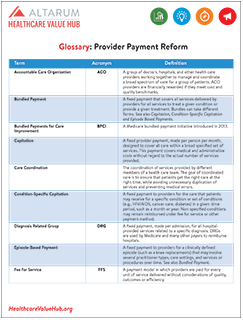Improving Value
Provider Payment Reform
Private and public payers are exploring new ways of paying healthcare providers (doctors, hospitals and others) to incentivize the provision of higher quality, more cost-efficient care. These alternative payment approaches are often compared to the fee-for-service (FFS) approach-the traditional method for paying providers.
Fee-for-Service (FFS): A payment model in which providers are paid for every unit of service delivered without consideration of quality, outcomes or efficiency.
Fee-for-service payments are, still, the most common method for paying practitioners today. On average, nearly 71 percent of physician practice revenue came from FFS payments in 2016.1 While sometimes appropriate, this payment approach has widely recognized flaws, including an incentive to over-treat, little incentive to coordinate care and little incentive to look at outcomes and quality in the context of patients’ overall course of treatment.
A number of alternative payment approaches, some old and some new, are being evaluated for their ability to deliver higher quality healthcare at a lower cost.
A straight-forward approach is to stop paying providers in cases where a certain type of medical error, called a “never event,” occurs. Never events include errors like surgeries on the wrong site, wrong patient or of the wrong type. In 2008, the Medicare program stopped paying for 11 such events and this approach was quickly emulated by state and private payers.
Payment reforms beyond nonpayment for never events fall into two major categories, often used in combination:
- A single payment for a group (or “bundle”) of healthcare services
- Varying payment depending on quality outcomes
A Single Payment for a Group (or “bundle”) of Healthcare Services
Paying providers a lump sum for a group of services reduces the incentive to over-treat because the payment stays the same regardless of the number of services they provide. Moreover, paying for a group of services creates an incentive for all the providers in delivering that care to work together to coordinate patients’ overall course of treatment. For this reason, providers who have established integrated operating structures – like Patient Centered Medical Homes, Accountable Care Organizations or Health Maintenance Organizations – are particularly well positioned to accept this type of payment. The group of services can be created around a diagnosis (e.g., all diabetes related care), a procedure (e.g., a knee replacement), or it can provide all the services for a patient for the year.
Bundled payments: The evidence with respect to condition or procedure-specific bundled payments (a.k.a Episode-of-Care Payments) is mixed, with some studies finding net savings from these arrangements with no negative effect on quality of care. While evidence of quality improvement is scarce, it is important that bundled payments remain tied to quality benchmarks to ensure that providers aren’t incentivized to undertreat patients to maximize profits.
Capitated payments/global budgets: Capitated payments and global budgets are similar to bundled payments in nature, but go further by paying providers a single lump sum for all services delivered to a specific patient/population during a certain period of time. Studies of Maryland's all-payer rate setting program, which capitates payments for all acute care hospitals in the state, show that the payment strategy has lowered per capita hospital spending growth; reduced potentially preventable complications and hospital admissions; and lowered out-of-pocket costs for Medicare beneficiaries with no negative affect on patient experience and hospital financial performance. However, undesired effects (specifically, increased Emergency Department use) were also observed.
Varying Payment Depending on Quality Outcomes
Quality measures can be (and often are) incorporated into FFS, bundled payment and even capitated payment models. The majority of quality measures in use today are process or efficiency measures, although the value of health outcome and patient satisfaction/experience measures is increasingly understood. A subset of these models (i.e., value-based purchasing initiatives) go further, tying provider payments to both quality and cost.
Payment variation can take the form of rewards (a.k.a. up-side risk), penalties (a.k.a. down-side risk) or both. Some common designs include:
- Pay-for-Performance (P4P): Physician reimbursements are tied to their performance on certain quality and efficiency measures. Providers that meet quality standards are eligible for financial rewards, whereas providers that do not meet quality standards may be penalized. The Hospital Readmission Reduction program is one example of this approach.
- Shared savings: Payers measure provider performance against quality and spending targets. Providers that meet these targets become eligible to share any savings they generate with the payer. Providers that do not meet the targets face no penalty.2
As with bundled payments, the track record of paying for outcomes is mixed. Problems with these reimbursement methods include the fact that many physicians believe that the quality measures used to determine reimbursement are inaccurate. Risk adjustment processes are still rudimentary and do not adjust for socioeconomic factors that are beyond providers’ control. As a result, physicians and hospitals caring for high-risk populations, like those located in poor urban areas, may be at a disadvantage when it comes to payment based on quality scores. Questions remain about which models are replicable and scalable in ways that allow providers to face a uniform set of incentives so that a broader swath of the population can reap the benefits.
Current evidence suggests that the best approach to provider payment reform include:
- Tailor the use of bundled and performance-based payments to the specific conditions and procedures where the evidence is strong. In these cases, an effort should be made to align payment methodologies and outcome metrics across payers.
- Complement financial incentives with non-financial incentives, like peer comparisons, to change undesirable practice or pricing behaviors. And where there is unwarranted practice variation but evidence for payment reform approaches is poor, consider the use of non-financial incentives alone as a first step.
- Recognizing that a role for FFS remains. This type of reimbursement is well suited for services that don’t lend themselves to a bundle – as well as discrete, high value services that we want more people to receive (for example, a flu shot). It must be noted, however, that controlling the rate of increase in FFS payments is important.
- Using centers of excellence to achieve better health outcomes for complex patients.
Notes
1. Albert Henry, Tanya, "Despite APM Participation, Fee for Service Still Dominates," American Medical Association (December 21, 2017).
2. Murray, Roslyn, and Suzanne F. Delbanco, "The Evidence on Shared Savings: Do We Know Enough?" Health Affairs Blog (July 17, 2018).
- Hub Research Brief: Bundles Payment Reform with Promise (July 2015)
- Practice Management News: Healthcare Price Transparency in New Hampshire Reduced Out-of-Pocket Costs (Feb. 11, 2019).
- Health Affairs blog: The Next Chapter in Transparency: Maryland's Wear the Cost (Oct. 19, 2017)
- Maryland's Wear the Cost website
- Health Affairs: Examining a Healthcare Price Transparency Tool: Who Uses it, and How They Shop for Care
- JAMA Editorial: Healthcare Transparency and Economic Theory
- LA Times: California fails at giving patients actual medical prices, report shows
- Boston Globe: Inurers asked to improve health cost websites







